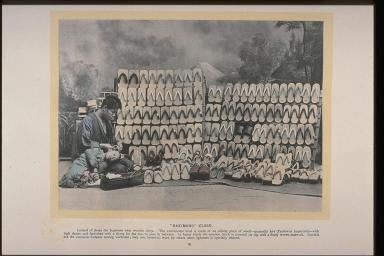”履物”<木靴>.靴のかわりに日本人は木靴(下駄)を履く.最もありふれた種類は高い歯の付いた長方形の木-普通は桐-で作られ指が間を通る紐(鼻緒)を備え付けた物である.よりよい種類では木の台は上部を見事に織られた敷物で覆われている.サンダル(草履) .../("Hakimono" (clogs). Instead of shoes the Japanese wear wooden clogs. The commonest kind is made of an oblong piece of wood - generally kiri (Paulowna imperialis) - with high skates and furnished with a thong for the toes to pass in between. In better ...)
| caption |
: |
”履物”<木靴>.靴のかわりに日本人は木靴(下駄)を履く.最もありふれた種類は高い歯の付いた長方形の木-普通は桐-で作られ指が間を通る紐(鼻緒)を備え付けた物である.よりよい種類では木の台は上部を見事に織られた敷物で覆われている.サンダル(草履) .../("Hakimono" (clogs). Instead of shoes the Japanese wear wooden clogs. The commonest kind is made of an oblong piece of wood - generally kiri (Paulowna imperialis) - with high skates and furnished with a thong for the toes to pass in between. In better ...) |
| note |
: |
|
| book title |
: |
日本生活の図絵 |
| author |
: |
タカシマ ステタ ( 高島 捨太 )/(Takashima, Suteta) |
| year |
: |
1896 |
| Library Number |
: |
YP/16/Ta |
| author |
: |
000043117 |
| GID |
: |
GL001082 |
| PhotoCD no. |
: |
C024064 |
